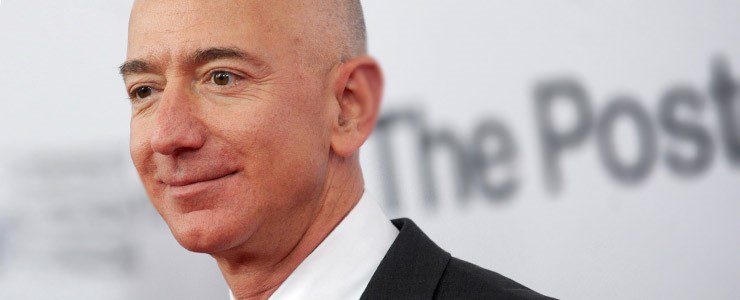
Entrepreneurs: Jeff Bezos & the Amazon story
Amazon is the world’s largest online retailer, with its founder, Jeff Bezos, having an estimated net worth of $142 billion, making him the richest man in the world, according to the Bloomberg Billionaire Index, published in February 2019.
The global business began life as a tiny start-up, launched by Bezos using a second-hand computer in his garage. Today, it accounts for around one-third of the United States’ e-commerce sales, employs more than 600,000 people across the world and owns big names, such as LOVEFiLM, IMDB, Zappos and Woot.
It also has its own TV and film studio Amazon Studios, owns the publishing arm Amazon Publishing and produces famous consumer electronic products, such as Fire tablets, Fire TVs, Echo devices and Kindle e-readers.
Amazon is the world’s largest provider of cloud infrastructure, as a result of its AWS subsidiary, while it also sells low-end AmazonBasics products – its own in-house brand.
Company origins
Bezos founded Amazon in July 1994, after leaving his vice-president position at Wall Street investment management firm DE Shaw and Co earlier in the year and relocating to Seattle, Washington.
He drew up a business plan for his new company (which became Amazon.com) after realising he should be getting on board with the growing internet boom. Originally, his idea was to simply launch an online book store.
Bezos chose the name “Amazon” (the world’s largest river) because he felt it conjured up the image of something on a massive scale. When Amazon was first launched, its tagline was “Earth’s biggest book store”.
Amazon was also ideal because it began with the letter “A”. In the early days of the internet, it was common practice for website listings to be displayed in alphabetical order.
Makeshift office
Bezos was very thrifty in the early days, until he got the business off the ground, working from his garage with makeshift furniture and his old computer. Although he took on a handful of staff as the business began to pick up, they worked from what they called “door desks”.
The desks were built using old doors, with legs fashioned from blocks of wood and attached with brackets! His insistence on not spending a lot of money on his premises contributed to Amazon’s growth, as no money was wasted and profits were ploughed back into the business.
Bezos had a simple philosophy for success. He said in an interview, “We aim to be earth’s most customer-centric company.”
Amazon’s mission was to “raise the bar of the customers’ experience” through using technology and the internet to help shoppers find and buy anything they required. It was also aimed at empowering businesses and content creators in order to maximise their success.
Rapid growth
The first book was sold on Amazon in July 1995. It was Douglas Hofstadter’s Fluid Concepts and Creative Analogies. This was the start of a period of rapid and massive growth for the e-store.
In the first two months alone, Amazon sold books across America’s 50 states and also exported to 45 other countries. By September 1995, sales already totalled $20,000 a week.
The company has continued to expand and survived hard times when the dot.com bubble of new e-commerce start-ups burst at the start of the 21st century. Its survival was largely thanks to Amazon sticking to its goal of being the world’s most customer-centric company.
To ensure no-one loses sight of their mission, every Amazon employee, including the CEO Bezos, has to spend time working on the customer service desk. They must take calls from customers for a few days each year, to ensure they have a good understanding of the whole company and how its processes work.
Amazon has built its reputation on its successful online customer experience, bringing trust and transparency to online shopping and setting the bar for customer service.
Amazon tech advances
Today, online consumer reviews are commonplace, but in the early days of e-commerce, they were seldom seen. Amazon was one of the first online businesses to display reviews, making the brand more transparent.
Amazon is also a market leader in cross-selling. Like online reviews, this is standard practice today in e-commerce, but Amazon pioneered the real-time product recommendation engine.
The company has also perfected a streamlined checkout experience. It’s easy for customers to search for and buy products, thanks to innovations such as one-click shopping.
One of Amazon’s biggest strengths is its ability to present a model that provides unprecedented customer service, seamlessly combining the purchasing and distribution arms.
Amazon also provides customer service for its Kindle products, even adding a “Mayday” button to its Kindle Fire tablet, where users have 24-hour live customer support.
Future of Amazon?
As the latest additions to the brand’s portfolio, the Amazon Fresh and Amazon Restaurants divisions are aiming to capture the grocery and meal delivery market.
The company’s Prime Pantry strategy is hoping to get more people to buy food, snacks and household supplies online, with its “Dash” buttons supporting one-click ordering of products.
Business analysts have said that Amazon needs to have a physical presence as well as an online one to continue its phenomenal growth. Never one to disappoint, Bezos is looking at introducing cashier-less “Go” convenience stores.
The first opened in San Francisco in 2018 and Amazon currently has six Go stores, with more planned for New York City and Chicago this year.
Bloomberg reported in 2018 that Amazon could be planning to open 3,000 Go stores by 2021, with the goal of becoming a major player in the convenience store, grocery and restaurant industries.
When you’re looking to launch and expand your business, reduce the hassle of finding and managing premises by taking advantage of coworking space at Headspace. Contact us to find out more about our flexible workspaces for the technology, media and creative sectors.
© MediaPunch Inc / Alamy Stock Photo



